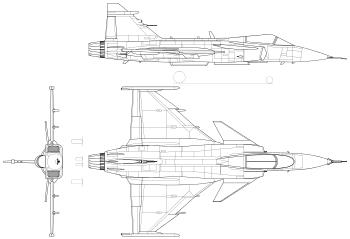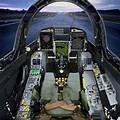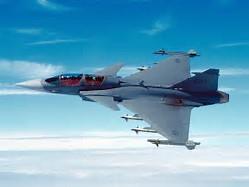S'sonic
Stealth
Menu
A free template by Lucknowwebs.com for WYSIWYG WebBuilder 8
Powered by Sispro1-S
Nigel G Wilcox
Paragon Of Space Publication
© Copyright Reserved - United Kingdom
Ideal Screen Composition 1024 x 768
SITEMAP
PSEUDO SCIENCE
SCIENCE RESEARCH
ABOUT
Desk
Supersonic
Stealth
Study
Menu
MAIN INDEX
Fastest Air Planes
Space
Transport
Menu
MiG-21 Fishbed
Saab JAS 39 Gripen
The Saab JAS 39 Gripen is a light single-engine multirole fighter aircraft manufactured by the Swedish aerospace company Saab. It was designed to replace the Saab 35 Draken and 37 Viggen in the Swedish Air Force. The Gripen has a delta wing and canard configuration with relaxed stability design and fly-by-wire flight controls. It is powered by the Volvo RM12, and has a top speed of Mach 2. Later aircraft are modified for NATO interoperability standards and to undertake in-flight refuelling.
Range: 2,019 mi Length: 46.26 ft Wingspan: 27.59 ft Passengers: 2 Manufacturer: SAAB Group.
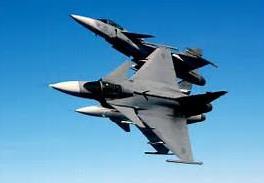
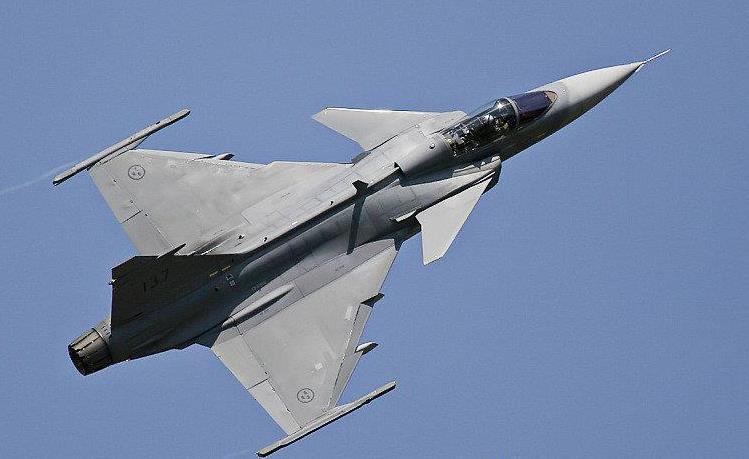
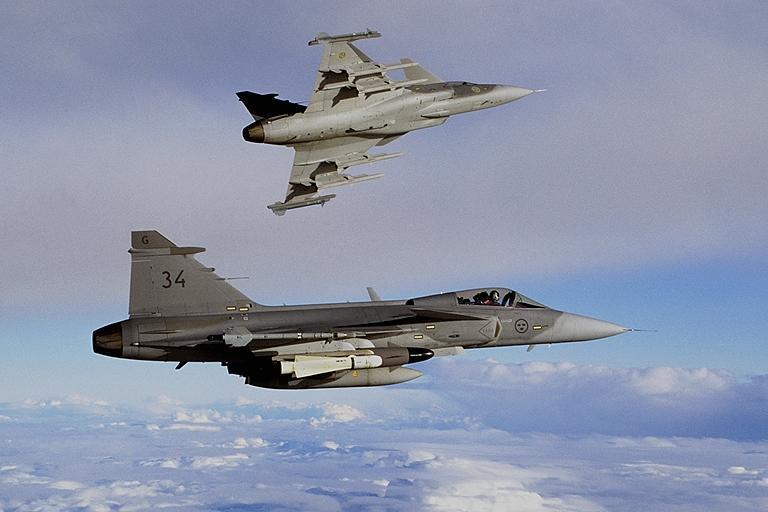

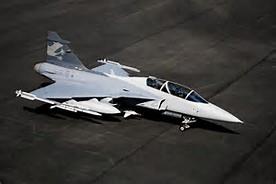

The Saab JAS 39 Gripen, in English it means Griffin, is a multirole and single-engine lightweight fighter which features fly-by-wire control flight system, relaxed stability design, delta wing and canards. The aircraft is developed by Saab, the Swedish aerospace company, which focused to replace the previous Swedish Air Force fighters: the Saab 35 Draken and 37 Viggen.
The Development of the Saab JAS-29 Gripen
The development was commenced in 1979 when the Swedish government tried to find a new aircraft with abilities to take the role of a fighter, attacker and reconnaissance aircraft. The necessary of a new versatile fighter was increasing in the height of the Cold War. Sweden thought they needed to prepare its own defense if the Soviet Union invaded the country.
After selecting several foreign fighters such as the F-16 Fighting Falcon, the F/A-18 Hornet, the Northrop F-20 Tigershark and the Dassault Mirage 2000, finally the Swedish government decided to build its own fighter and the Saab was selected to handle its development and manufacturing.
The Swedish government study aimed for a multirole or swingrole platform capable of “JAS”, which stands for Jakt (air-to-air), Attack (air-to-surface), and Spaning (reconnaissance). The study led to the JAS-39 concept which later the aircraft becomes a Swedish commodity in international air defense market. However, senior officials of the Indian Air Force, a potential operator of the fighter, identified the Gripen NG’s high reliance on US-supplied electronics, weaponry, and the GE F414 engine as a factor that may hamper its export potential.
The Design of the Saab JAS-29 Gripen
The Saab JAS-29 Gripen is a multirole fighter which powered by single GE F404-derived Volvo-Flygmotor RM12 with afterburner. The aircraft can reach the maximum speed of Mach 2. The Saab JAS-29 Gripen features delta wing and canards below its cockpit. There are eight hardpoints allowing the aircraft to mount various bombs and missiles, added on by the 27 mm Mauser BK-27 cannon.
The Saab JAS-29 Gripen is smaller than the Viggen, but with approximately the same payload-range characteristics. The configuration features for a high manoeuvrability in addition to improved takeoff and landing operation. The Gripen likewise comes with a low drag, this enables it to fly speedier, have enhanced range, and bring a larger payload. The 100 % built-in avionics create it a “programmable” aircraft, shifting the software can give extra mission profiles.
The JAS 39 was thereby, with outstanding performance, capable to take-off from snow-covered runways of merely 800-metre (2, 600 ft). Yet another prerequisite is a short-turnaround time of basically 10 minutes by a technician and five conscripts; meaning re-arming, refuelling, required inspection and servicing must be completed in less than 10 minutes between flights.
The Gripen employs the modern PS-05/A pulse-doppler X-band radar, created by Ericsson and GEC-Marconi, which is based upon the latter’s leading-edge Blue Vixen radar for the Sea Harrier (which influenced the Eurofighter’s CAPTOR radar as well). The radar is competent of detecting, tracking down and pinpointing targets 120 km (74 mi) away, and instantly keeping track of multiple targets in the upper and lower spheres, on the ground and sea or in the air, in all weather conditions. It can help a number of air to air missiles at beyond visual range to several targets at the same time.
Commencing in 2003, Saab and BAE engineered the Cobra Helmet Mounted Display System (HMDS) for the Gripen and other aircraft, based on the Striker HMDS utilized on the Eurofighter. By 2008, the Cobra MDS was totally integrated into the aircraft, obtainable as an option in the export versions and since retrofitted into both Swedish and South African Gripens.
The concept of many parts of the airframe do not need maintenance or are low cost to keep up, together with the physical structuring of the aircraft, indicates that that Gripen would have a significantly longer life than the preceding Viggen, anticipated to be approximately 50 years.
The Operators
Current operators are Czech, Hungary, South Africa, Sweden, Thailand and the UK (only for advanced pilot training). Some other countries seemingly will be potential operators; they are Brazil, Bulgaria, Croatia, Denmark, Netherlands, Oman, Slovakia, Switzerland and United Kingdom.
The Variants of the JAS 39
JAS 39A - Fighter version that first entered service with the Swedish Air Force.
JAS 39B - Two-seat version of the A variant.
JAS 39C - NATO-compatible version of Gripen which can be refueled during flight.
JAS 39D - Two-seat version of the C variant.
Gripen NG - The NG stands for Next Generation, a proposed version which powered by the F414G, a new engine that allows the fighter to have increased fuel capacity, higher payload, upgraded avionics and other improvements.
Cost: $40,000,000 per unit
Role: Fighter, attack and reconnaissance aircraft
National origin: Sweden
Manufacturer: Saab Group
Design group: Industrigruppen JAS, FMV
First flight: 9 December 1988
Introduction: 1 November 1997
Status: In service
Primary users: Swedish Air Force
South African Air Force
Czech Air Force
Hungarian Air Force
Produced: 1987-present
Number built: Approx. 247
Program cost: US$ 13.54 billion (2006)
Unit cost: US$ 30-60 million for JAS 39C
General characteristics
Crew: 1 (2 for JAS 39D)
Payload: 5,300 kg (11,700 lb)
Length: 14.1 m (46 ft 3 in); two-seater: 14.8 m (48 ft 5 in)
Wingspan: 8.4 m (27 ft 7 in)
Height: 4.5 m (14 ft 9 in)
Wing area: 30.0 m² (323 ft²)
Empty weight: 6,800 kg[372] (14,990 lb)
Loaded weight: 8,500 kg (18,700 lb)
Max. takeoff weight: 14,000 kg (31,000 lb)
Wheel track: 2.4 m (7 ft 10 in)
Powerplant: 1 × Volvo RM12 afterburning turbofan
Dry thrust: 54 kN (12,100 lbf)
Thrust with afterburner: 80.5 kN (18,100 lbf)
Performance
Maximum speed: Mach 2 (2,204 km/h, 1,190 kn, 1,370 mph) at high altitude
Combat radius: 800 km (497 mi, 432 nmi)
Ferry range: 3,200 km (1,983 mi) with drop tanks
Service ceiling: 15,240 m (50,000 ft)
Wing loading: 283 kg/m² (58 lb/ft²)
Thrust/weight: 0.97
Maximum g-load: +9 g
Armament
Guns: 1× 27 mm Mauser BK-27 revolver cannon with 120 rounds (single-seat models only)
Hardpoints: 8 (three on each wing and two under fuselage) and provisions to carry combinations of:
Rockets: 4× rocket pods, 13.5 cm rockets
Missiles:
6× AIM-9 Sidewinder (Rb.74) or IRIS-T (Rb 98) or A-Darter
4× AIM-120 AMRAAM (Rb.99) or MICA
4× Meteor
4× AGM-65 Maverick (Rb.75)
2× KEPD.350
2× Rbs.15F anti-ship missile
Bombs:
4× GBU-12 Paveway II laser-guided bomb
2× Bk.90 cluster bomb
8× Mark 82 bombs
Avionics
PS-05/A Pulse-Doppler radar
